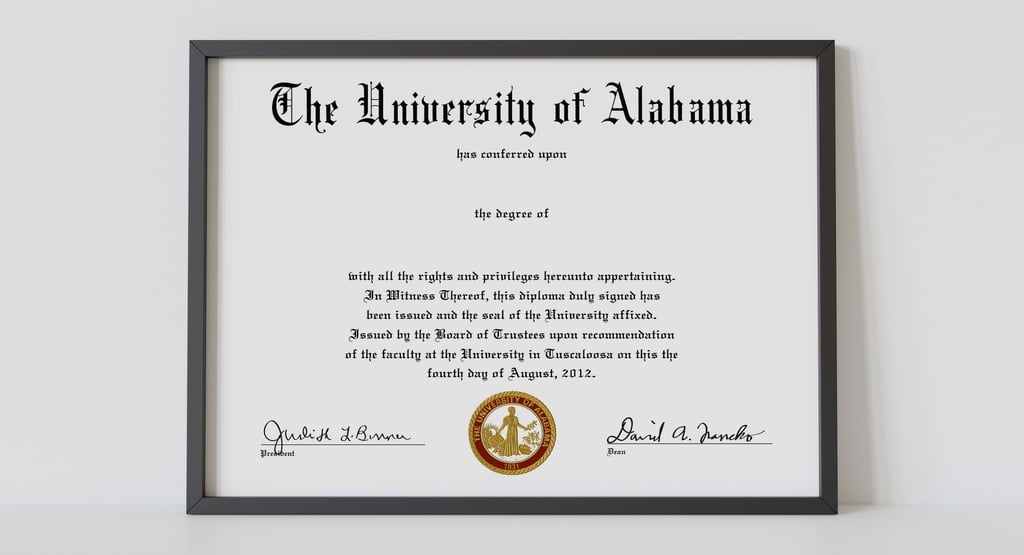Identifying Fake Degree Certificates: Complete Guide for Employers and Students
Fake degree certificates are a growing problem worldwide. Online "diploma mills" and counterfeit sellers are spreading fake qualifications faster than ever. Employers and educational institutions need to be able to identify these fraudulent degrees. Doing so helps protect their reputation, ensures they hire or admit qualified individuals, and keeps them compliant with legal requirements. Identifying fake degrees is essential to maintain trust and integrity in education and the workplace. In the UK, using a fake qualification is a crime under the Fraud Act 2006, punishable by up to ten years in prison. Yet, studies show nearly 80% of employers don't verify academic credentials. Not checking qualifications can cause significant financial losses and harm a company's reputation. Below are clear, practical steps to help detect and verify fake degree certificates.


Examine the Design and Material Quality
The first sign of a fake degree is usually its physical appearance. Genuine certificates feature:
Embossed logos or raised seals that you can feel with your fingertips.
High-quality paper stock that doesn't smudge or tear easily.
Ink signatures, not printed ones, for university officials or registrars.
Holograms or watermarks are visible when held up to light.
Check for blurry logos, misaligned text, or spelling errors. Fake certificates may copy the general design but often get small details wrong, like fonts, spacing, or paper quality. These mistakes can reveal that a certificate is not real.
Scrutinize the Language and Terminology
Language is another key clue. Real universities use exact wording and consistent formatting on their documents. For example, UK universities stopped using Latin terms like "cum laude" over ten years ago. If a UK degree shows "cum laude" or "magna cum laude," it is likely fake.
Official names also matter—for instance, "The University of Manchester" is correct, while "Manchester University" is not. Checking these details helps identify fake degrees. Also, check the punctuation, capitalization, and grammar. Fake documents often have small language mistakes that real institutions would not make.
Verify the University's Location and Website Domain
A genuine certificate must come from an accredited and recognized institution. To confirm authenticity, conduct a quick online check:
Verify the official address — Search the university’s name on Google Maps or through its verified institutional listing.
Check the domain format — In the UK, legitimate universities use domains ending in “.ac.uk,” while in the US, they typically use “.edu.”
Inspect the website content — If the site’s domain looks suspicious, contains spelling errors, or redirects to non-academic pages, it’s a clear sign of a fake university or a cloned website.
Confirm Accreditation and Recognition
Many fake schools use names that sound real. Always check if the university is officially recognized by the proper education authority to ensure the certificate is genuine. In the UK, you can use HEDD (Higher Education Degree Datacheck), a government service, to verify degrees. In the U.S., the Department of Education offers an online database to check if institutions are accredited and legitimate. If a university isn't accredited, its degree has no legal or academic validity.
Use Digital Verification Tools and Databases
With digital credentials, checking degrees has become quicker and more reliable. Employers can use:
Blockchain-based verification systems, such as DiplomaChain, Credly, or Gradintel.
Official alumni databases where graduates can share verified electronic copies.
Third-party verification agencies that cross-check data directly with institutions.
Blockchain records cannot be altered or forged, making them an effective solution to verify degree authenticity in seconds.
What Are Diploma Mills?
Diploma mills are fraudulent businesses that sell fake academic degrees for a fee. They often claim to offer “life experience credits” or promise instant graduation without legitimate coursework or verification. These operations are designed to deceive individuals and employers alike. Common warning signs include:
No physical address, verified campus, or faculty information.
Unrealistic degree timelines (e.g., “Get your MBA in 10 days”)
Poorly designed, unprofessional websites focused on speed and delivery rather than genuine academics.
Requests for payment before admission approval or document validation.
Use of misleading names resembling reputable universities, such as “Cambridge International College”, to appear credible.
Diploma mills can seriously damage your professional reputation and may even constitute fraud if used for employment or immigration purposes. Always verify the legitimacy of an institution through recognized accreditation bodies before enrolling.
Employer Verification Checklist
Employers can implement a structured process to safeguard against fake degrees:
Request original copies of certificates during recruitment.
Cross-check details (student name, course title, completion date) with the issuing institution.
Use official databases like HEDD (UK), WES (Canada), or the National Student Clearinghouse (U.S.).
Document verification outcomes as part of compliance records.
Train HR teams to recognize fraudulent design elements and language cues.
A clear verification policy ensures compliance and builds a culture of integrity within the organization.
What to Do If You Suspect a Fake Degree?
If a degree looks suspicious due to formatting errors, unverifiable university details, or inconsistent information, it's important to act carefully. Don't suspect aloitation or create issues. Inis doesn't use a straightforward, step-by-step process: verify the university, check the student's records, and verify the student's records. It handles the situation methodically and ensures any action is accurate and legally safe.
1. Verify Directly with the Issuing University
Start by contacting the university's registrar and admissions using the official contact information from the school's tool, not the details. Most universities can confirm whether the certificate's school date and student certifications. If the university cannot find the student record or hesitates to verify it, treat this as a warning sign. Always use official verification to confirm the certificate is genuine before further action.
2. Use Recognized Verification Services
In the UK, HEDD (Higher Education Degree Datacheck) is a government-backed service that verifies university degrees. Tools like World Education Services (WES) or the U.S. National Student Clearinghouse can confirm authenticity for international degrees. These services provide reliable, traceable reports, helping employers stay compliant and keep accurate records of employees ' information.
3. Report to the employees
Verification confirms that a degree is fake. Report it to official fraud agencies, such as Action Fraud UK, the National Crime Agency, for severe criminal offenses, and contact the appropriate higher education or law enforcement authority. Reporting helps prevent the spread of fake documents and protects other organizations from falling victim to counterfeit qualifications.
4. Maintain Confidentiality and Avoid Public Accusations
Do not confront the person publicly or accuse them without proof; this could risk defamation. Keep the investigation private until verification is finished. All discussions should stay within HR or the compliance team and be adequately documented to ensure a professional and secure process.
5. Preserve All Supporting Evidence
Keep copies of emails, certificates, correspondence, and verification results. These records may be needed for internal reviews, insurance claims, or audits. Proper documentation also shows that due diligence was followed, which can be important in legal situations.
6. Strengthen Internal Policy Afterward
After resolving the case, review your hiring and background-check policies. Consider requiring degree verification before making job offers and training HR staff to recognize warning signs. A straightforward internal process helps ensure similar issues are handled quickly and consistently in the future.
Preventive Measures for Employers and Institutions
Prevention is more effective than reaction. Here’s how organs can stay protected in every background check.
Partner with reputable screening providers that Here'scure verifHere'scureIs.
Educate HR. Here's the verification.
Encourage candidates to submit digitally verified certificates instead of scans or photos.
Institutions should provide tamper-proof digital degrees to help prevent fraud and misuse.
Fake degree certificates threaten the credibility of the entire education system. Employers who fail to verify qualifications risk hiring underqualified staff, damaging their reputation, and facing legal consequences.
Organizations can protect themselves and maintain trust by carefully verifying degrees, from checking the design to confirming digitally. In a world where fake qualifications are easy to access, staying vigilant is the best defense.
Frequently Asked Questions
Are fake degrees illegal in the UK?
Yes. Under the Fraud Act 2006, using a fake degree is a criminal offence punishable by up to 10 years in prison.
How can employers verify a UK degree?
Through HEDD (Higher Education Degree Datacheck), the official UK platform for academic verification.
What is a Diploma Mill?
A Diploma Mill is an unaccredited entity that sells fake academic degrees without coursework or legitimate assessment.
Can blockchain technology verify degrees?
Yes. Blockchain provides tamper-proof digital records, ensuring certificates cannot be altered or forged.
What should I do if I suspect a fake certificate?
Contact the issuing university or report it to Action Fraud for further investigation.
